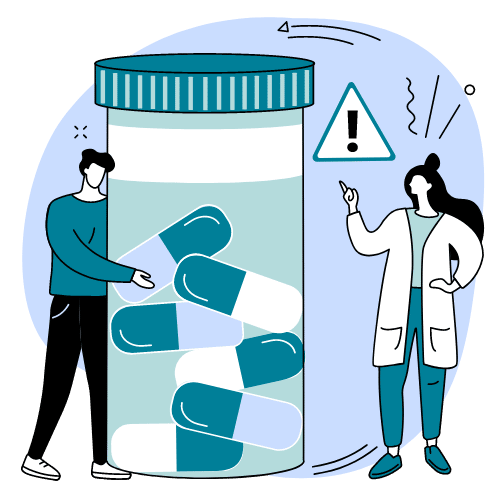Alcohol use and addiction is a prevalent problem in the United States. Unfortunately, it can sometimes be hard to determine if someone is abusing alcohol due to the fact that many alcoholics go to great lengths to hide their drinking. Additionally, the severity of the alcohol use disorder can also impact the signs a person shows of alcohol use.
If you or a loved one are in need of an alcohol addiction treatment program in Massachusetts, reach out to us at 888.451.5895.
7 Warning Signs of Alcoholism
The more severe the addiction, the more likely others will begin to notice alcoholic behaviors. If you believe a loved one is struggling with alcoholism, here are a few common signs to look for.
1. Experiencing Blackouts
People who use alcohol will often experience blackouts on a regular or semi-regular basis. A blackout is when a person loses the ability to form short-term memories for a period of time due to high levels of alcohol content in the blood and body. The individual will be unable to recall what happened during this time once he or she recovers from the blackout. [inline_cta_one] A blackout is a way for the body to let someone know he or she is drinking too much. When a person experiences blackouts regularly, this may be a sign that he or she is struggling with alcohol use or addiction.
2. Inability To Control One’s Drinking
The inability to control one’s drinking is one of the telling signs of alcoholism. A person may say “I’m only going to have one drink” and end up drinking to excess and becoming intoxicated despite his or her best intentions. If your loved one regularly drinks more than he or she intended, this may indicate alcohol addiction.
3. Hiding Or Lying About Drinking
When a person is regularly abusing alcohol, he or she may go to great lengths to hide from others how much alcohol is being consumed. For example, a person may go out to the bar with friends and only have a few drinks but then return home and consume more alcohol in private. Someone struggling with alcohol use may also sneak away to drink alcohol while in a social setting so other people don’t realize how much the individual is drinking.
4. Physical Changes
Many people who drink heavily on a regular basis will begin to show physical signs of alcohol use. For example, they may begin to gain or lose weight or feel constantly bloated. A person may also look regularly look tired if he or she is consuming alcohol at night, as alcohol can prevent the body from getting an adequate night’s sleep. Someone who uses alcohol may also begin to exhibit shaky hands and visible sweating when not drinking as a result of a hangover or withdrawal symptoms.
5. Work or Legal Trouble as a Result Of Drinking
Alcohol addiction often interferes with a person’s ability to perform well at work. He or she may begin to call in sick more often and perform poorly when at work due to a hangover or being intoxicated. Additionally, someone may face legal trouble due to his or her alcohol use. A person may be charged with a DUI or multiple DUIs as a result of driving while intoxicated. Some people may behave in illegal or risky ways, such as stealing or vandalizing property, while under the influence of alcohol, resulting in legal implications. When this becomes a regular pattern in a person’s life, it’s often a good indicator that he or she is struggling with alcohol use.
6. Experiencing Withdrawal Symptoms When Not Drinking
Many people experience the tell-tale hangover from consuming too much alcohol the night before at least once in their lives. However, regular hangovers – which are the body’s way of withdrawing from alcohol – can be a sign of alcohol use. Common symptoms of alcohol withdrawal include:
- Shakiness
- Sweating
- Upset stomach or vomiting
- Anxiety
- Irritability
- Headache
- Increased heart rate
- Insomnia
- Enlarged pupils
- Tremors in the hands
Alcohol withdrawal can begin as soon as eight hours after the last drink. The more severe the symptoms, the more dependent a person may be on alcohol.
7. Continuing to Drink Despite Consequences
Another prominent symptom of alcohol addiction is when a person continues to drink despite the consequences. People who are addicted to alcohol often feel that they are unable to go without the substance despite all of the trouble it has caused them. If your loved one refuses to cut down or quit drinking in spite of obvious consequences, he or she may be addicted to alcohol.
Getting Help for Alcoholism at Swift River
Alcohol is a powerful and highly addictive substance that can wreak havoc on every aspect of a person’s life when used. Alcoholism can result in consequences that include the deterioration of relationships, the loss of or inability to keep jobs, and severe health conditions, to name just a few. Many people will need professional help to successfully quit drinking and stay sober in the long run. Swift River is a state-of-the-art rehab facility that offers personalized programs of recovery for individuals struggling with an addiction to alcohol. Our evidence-based and comprehensive approach to addiction ensures that a person’s needs are met and that he or she is given the opportunity to heal mentally, spiritually, and emotionally. To learn more about the warning signs of alcoholism, contact a Swift River treatment specialist today at 888.451.5895.












